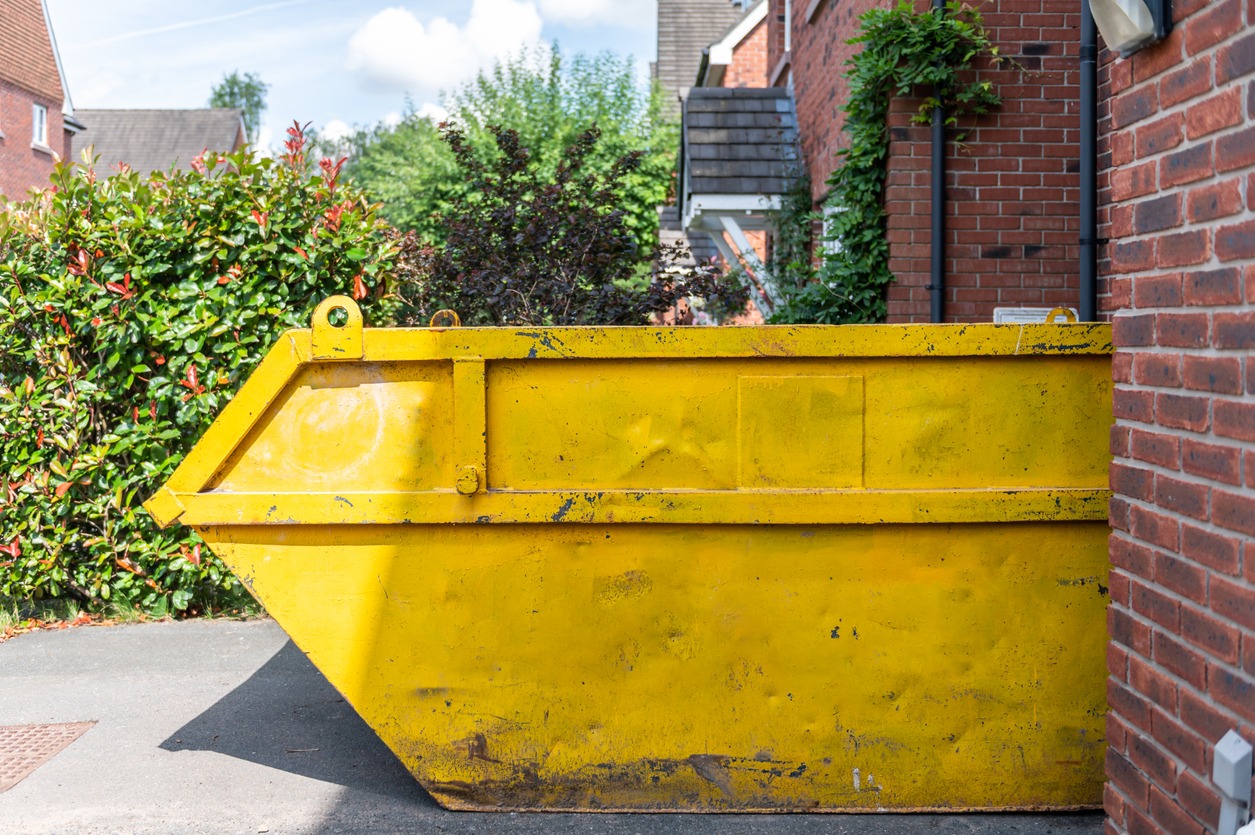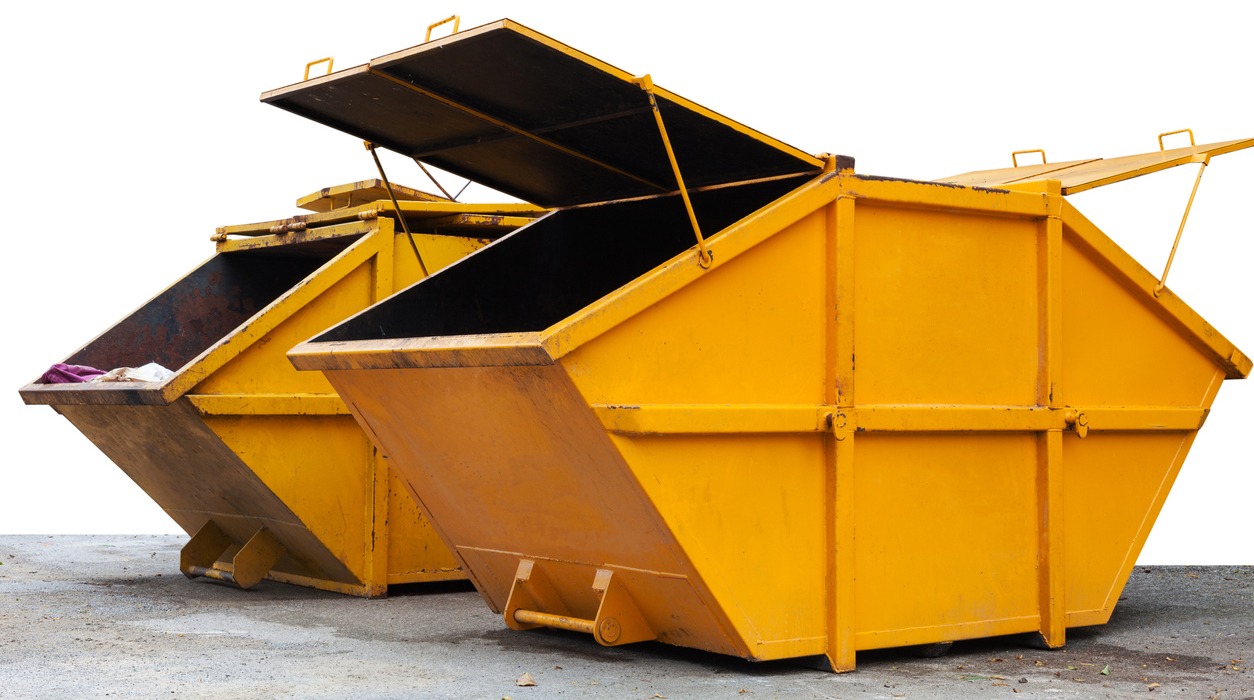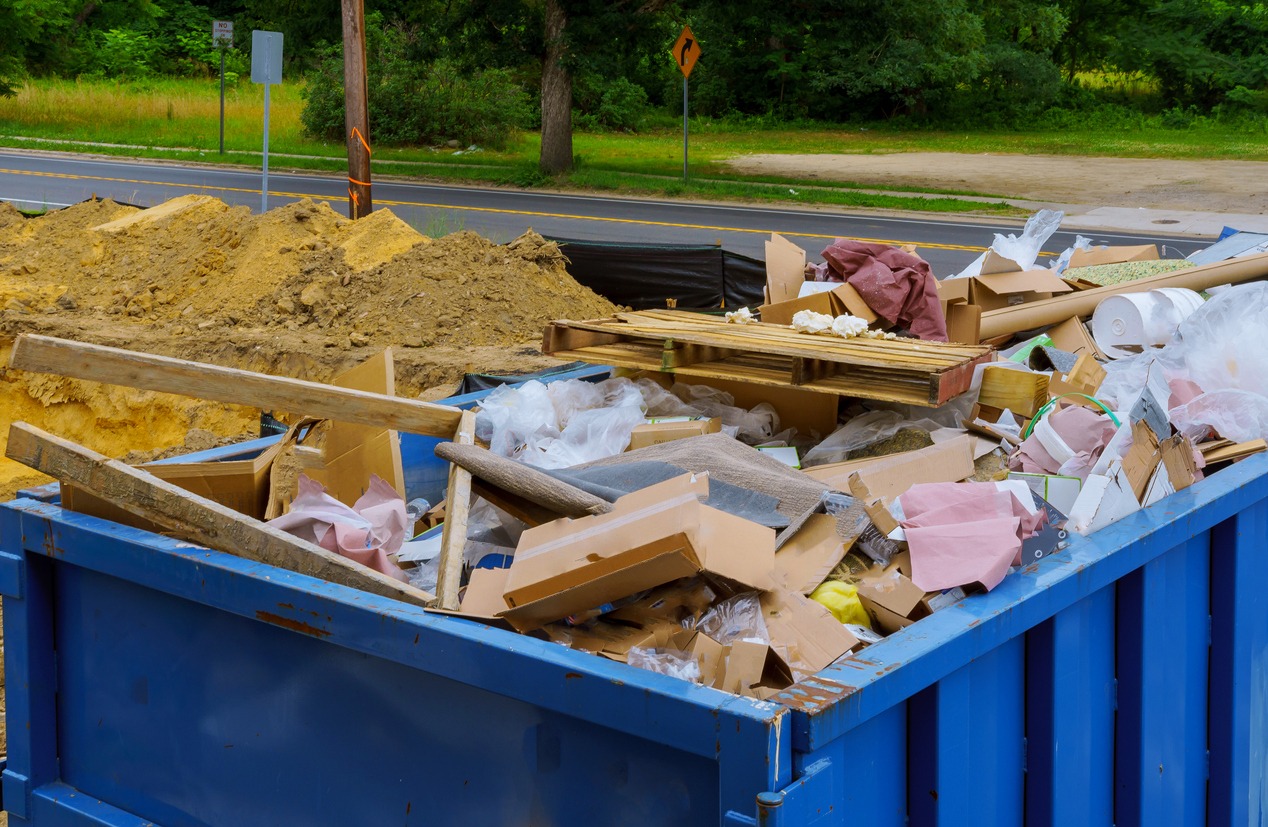Whether you’re moving, sprucing up your space, or giving your home a makeover, skip bins offer a hassle-free way to dispose of large amounts of bulky waste. Whether it’s getting rid of that old, broken furniture or clearing out a demolition job at your home, there is a right-sized skip bin for you. With our one-off collection, you can start fresh without any hassle.
What’s a Skip Bin?
A skip bin, often referred to simply as a “skip,” is a large container used for the temporary storage and transportation of waste materials that usually come from construction, renovation, demolition, or other types of projects that produce huge amounts of debris and rubbish. Skip bins are commonly used on construction sites, residential properties, and commercial locations where waste disposal is required.
A skip bin is a big open-topped container designed to be loaded onto a special type of truck. Skip bins usually have a unique shape – either like a trapezium or two stacked trapezoids. The lower part of the skip bin has a smaller edge at the bottom and a longer edge at the top, making it easier to load. There’s often a sloping floor or wall at each end.
These bins have two lugs on each side for attaching chains, which allows the heavy skip bin to be lifted onto and off a skip truck or lorry using a special crane. Some skips even have a large door at one end that swings down for easy manual loading and unloading, and these are called ‘drop-door skips.’
Skips are built to handle rough use by workers and tradespeople. They come in various sizes, from small 2-meter mini-skips to massive 40-meter roll-on/roll-off skips. While these large bins can hold a lot of waste, it’s important to note that most lorries are limited to carrying around 7.5 tons of material in the container. As a point of reference, a typical small skip, when empty, weighs about 187 kilograms.
Types of Skip Bins
Skip bins come in various types and sizes to accommodate different types of waste and project requirements. Here are some common types of skip bins:
- Marrel Skip Bins: These are the most common type of skip bins and have a trapezoidal shape. They have a distinctive sloping floor or wall at each end. Marrel skip bins are versatile and used for a wide range of waste types, including general household waste, construction debris, and green waste.
- Hook Lift Bins: Hook lift bins are larger and more robust than marrel skip bins. They are designed to be loaded onto a specialized hook lift truck using a hook arm. Hook lift bins are suitable for heavy and bulky waste, such as construction materials and industrial waste.
- Roll-on/Roll-off (RoRo) Bins: RoRo bins are massive and are typically used for large-scale commercial or industrial projects. They are loaded onto a truck using a rolling mechanism. RoRo bins are ideal for handling substantial volumes of waste and are commonly used in construction and demolition sites.
- Mobile Skip Bins: These are smaller, trailer-mounted skip bins that can be easily moved around with a vehicle. Mobile skip bins are convenient for residential cleanups, garden waste removal, and small-scale renovation projects.
- Skip Bags: Skip bags are a flexible and convenient alternative to traditional skip bins. They are made of sturdy materials and can be stored flat until needed. When filled, they can be picked up and disposed of by waste removal services. Skip bags are suitable for small to medium-sized cleanup projects.
- Specialty Skip Bins: Some skip bins are designed for specific waste types, such as hazardous waste, medical waste, or electronic waste. These specialty bins are typically used in specialized industries and require compliance with specific regulations.
- Compactor Bins: Compactor bins are designed to compress waste, reducing its volume and allowing for more efficient disposal. They are commonly used in commercial settings with high waste generation rates, like restaurants and businesses.
- Drop-door Skip Bins: These skip bins have a large hinged door at one end, allowing for easy loading and unloading of heavy or awkward items. Drop-door skips are convenient for projects where manual handling is required.
- Open Skip Bins: These are wide-open and make tossing waste easier. It is often at construction sites.
- Enclosed Skip Bins: Enclosed skip bins are fitted with covers or lids to prevent waste from spilling out and to prevent unauthorized access. They are often used in urban or residential areas to maintain cleanliness and safety.
The choice of skip bin type depends on the specific waste materials you need to dispose of, the volume of waste, the available space for placement, and the regulations and requirements in your area. It’s important to select the right type and size of skip bin to ensure efficient and responsible waste management for your project.
Practical Uses for Skip Bins
Skips are like trusty workhorses that can handle it all, from home renovations to handyman projects and greenery cleanups. They come in handy for various tasks, such as:
- Construction and Demolition: They’re useful for holding the mess left behind by building, renovating, or demolishing structures. Things like bricks, rubble, and construction debris are often handled by skip bins.
- Garden Cleanup: Skips are perfect for taming unruly garden waste like branches, leaves, and dirt.
- Industrial Scrap: Factories that churn out loads of scrap metal often rely on skips to keep things tidy.
- Cleanup Projects: When you’re tackling a massive cleanup job, skips are there to haul away mountains of stuff.
- Material Transport: Skips can double as a way to transport building supplies to a site and then cart away the waste when the job’s done.
Skip-hire companies usually slap a “level fill” reminder on the sides to keep things safe and maximize their earnings. Some folks get creative and use old doors or scrap material to boost the sides but beware – if it’s overloaded, extra fees might kick in.
Skip Bin Sizes for Home Use
For home use, you’ve got a few size options:
- Miniature Skip (2 m): Good for around 25-35 black bin bags. It is ideal for small kitchen makeovers and garden waste, and it fits neatly in most driveways.
- Medium Skip (4 m): Holds about 45-55 black bin bags, perfect for kitchen revamps and household waste, with a size that suits most driveways.
- Builders Skip (6 m): With space for roughly 60-70 black bin bags, it’s great for renovation projects and clearing out your attic or house. It can handle around 6 tons of soil or hardcore.
- Large Builders Skip (8 m): A bigger one at 80-90 black bin bags, roughly the size of a large family car. Perfect for construction gigs or massive home or garage cleanouts. It can take about 8 tons of soil or hardcore.
Advantages of Opting for Skip Bins
1. Convenient
One big perk that makes skip bins a top choice for many is the sheer convenience of it all. Just call a skip bin service, let them know what you need, and they’ll set you up with a skip bin right in your vicinity. No need for you to embark on a scavenger hunt to find the nearest landfill. These providers bring the skip bin to your doorstep, saving you time, energy, and a trip to their office. They offer a variety of skip bin services, so discussing your specific requirements helps them tailor the perfect solution. With a skip bin, saying goodbye to all your rubbish, whether it’s garden clippings, construction debris, or everyday household junk, is a breeze.
2. Eco-Friendly Approach
Hiring a skip bin is not only convenient but also environmentally friendly. Going skip-less might mean you’re not going to do a sustainable way of segregating trash. This could inadvertently add to landfill woes, causing harm to our planet in the long run. Skip bin hire agencies are experts in waste disposal and sustainability. They’re skilled in separating biodegradable, non-biodegradable, and recyclable materials, ensuring proper recycling practices. They can even spot recycling errors. What’s more, they rescue and recycle salvageable items whenever possible.
3. Safe Way to Handle Waste
Proper waste management calls for safety measures, especially when dealing with hazardous materials. To ensure your well-being, opting for a skip bin is a smart and secure choice. Your role is simply to toss the trash into the container; the professionals take it from there, handling the removal from your property. This means you can shield your home and loved ones from exposure to hazardous waste. What’s more, these experts know the ins and outs of waste removal techniques. From donning protective gear to employing the right methods, you can rest easy knowing they’ll prioritize the safety and health of everyone involved.
4. Available in different sizes
Skip bins don’t come in a one-size-fits-all package. They come in different shapes and sizes, so you can pick the one that fits your needs. If you’re unsure which size suits your waste, don’t sweat it. Just reach out to the sales team, and they’ll gladly give you a hand in choosing the right one. Whether you want to collect your trash over time or clear it all out at once, skip bin companies offer a range of options to cater to your waste management preferences.
5. Saves Time and Money
When it comes to tossing out your trash, renting a skip bin is the easiest, quickest, and most cost-effective route. Plus, it spares you the hassle of hauling your waste to a disposal site, saving you both time and effort. You’ll cut down on gas expenses since you won’t need to make that trip to the landfill.
6. User-Friendly
Skip bins are as user-friendly as it gets. No rocket science is involved here – anyone can figure it out without needing expert guidance. Just pop open the bin covers when it’s time to toss in your waste. And if you’re dealing with hefty stuff, grab a helping hand from pushcarts, trolleys, or wheelbarrows to ease the load into the skip bins. It’s a much easier way to spare your muscles from overexertion.
What Goes in a Skip Bin?
While not everything is fair game for your skip bin, you can toss a wide range of items in there, making your home cleanup a breeze! Professional skip bin providers handle the disposal for you, making life simpler.
Here’s a general list of items that can find their way into your skip bin:
- Clothes, toys, newspapers, books, and magazines
- Kitchenware and white goods (think fridges and washing machines)
- Glass bottles and jars
- Electronics like TVs, DVD players, game consoles, computers, and accessories
- Carpet, furniture, and those trusty cardboard boxes
- Non-electrical fittings
- Garden goodies like soil, leaves, grass, branches, and twigs
- Renovation remnants such as bricks, tiles, concrete, dirt, metal, and steel
However, when it comes to items that are harmful to the environment or downright risky, you’ll need to take a different route. These materials can pose a threat to you, the skip bin crew, and Mother Nature. For these, you’ll want a specialist who knows how to handle them safely.
Here’s the scoop on what’s a no-go in your regular skip bin:
- Asbestos
- Food waste
- Batteries (both car and household)
- Gas bottles
- Paint
- Oil heaters
- Chemicals of any kind
- Insulation of any kind
- Fire extinguishers
- Explosives
- Solvents
- Petrol and oil
- Poisons
- Medical waste
- Car tires
When tossing in white goods like fridges, make sure they’re degassed and the doors are removed. Plasterboard is a tricky one, too – it can contaminate the entire bin, but some skip-hire companies may allow small quantities if properly wrapped and placed on top.
If prohibited stuff gets into the skip, you might have to sort it out or pay extra for specialized disposal.
Do’s and Don’ts in Using a Skip Bin
Do’s:
- Make sure there’s enough space for the driver to safely attach lifting chains.
- Allow for easy and secure access.
- Keep the bins where our Waste Management driver puts them.
- Fill the bin only to the top so it can be covered during transport and travel safely on the road.
- Give us a call if you need a pickup or an extra bin.
- Ensure bins have ample space around them for easy access.
Don’ts:
- Set up scaffolding too close to the bin.
- Overfill the bin past the top.
- Move bins under powerlines.
- Scatter overflow waste around the bin.
- Attempt to drag or push bins to a different spot.
- Place the bin under a fixed object like a canopy or air conditioning unit.
Bottom Line
Skip bins are easy to use, and you can hire them easily. Just take a look around your local area, and you’ll discover a trustworthy skip bin company nearby. Given all the perks we’ve talked about, it’s clear that this waste management approach beats the hassle of making solo trips to the landfill any day.


